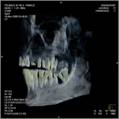12 August 2007

Tooth solves Hatshepsut mummy mystery
Archaeologists used a missing tooth to positively identify the mummy of Hatshepsut, daughter of Pharaoh Tuthmosis I and wife of Tuthmosis II, her half-brother. She reigned between 1498-1483 BCE as the fifth pharaoh of the 18th Dynasty.
She was more powerful than either of her more famous female successors, Nefertiti and Cleopatra.
The mummy was found in Tomb KV60, which was not a royal tomb, which is a small, undecorated tomb located in front of KV20. The real tomb of Hatshepsut. KV60 is actually a perfect cache for the reburial of mummies. Howard Carter, the discoverer of the tomb of Tutankhamun, had excavated this tomb in 1903, and found two mummies: one, a small woman, found inside an 18th Dynasty coffin inscribed for a royal nurse In. The other was a hugely obese woman, discovered on the floor next to Sitre-In’s coffin. We know, from other sources, that Hatshepsut’s wet-nurse was named Sitre-In, and that the last two letters of this name appeared on the coffin from KV60. Based on this fact, and the location of KV 60 close to KV 20, it was, and it is, the more confusing tombs in the Valley of the Kings because it contained two unidentified mummies, both of them women.
The archaeologists had four mummies to CT-scan. The two from KV 60, and the two from DB320, and they scanned the mummies that are believed to be most closely related to Hatshepsut: the mummy that might be Thutmose I, Hatshepsut’s father; Thutmose II, her husband and probably her brother; and Thutmose III, her stepson.

In addition, The Egyptian team scanned also some objects, Hatshepsut’s canopic jars and a wooden box bearing her cartouches that was found inside the DB320 cache. In addition to mummified viscera, there was a single tooth inside the box so it seemed that during the mummification of Queen Hatshepsut, the embalmers put into the box anything that was loosed from the body during the mummification process. The other surprise in the box confirmed this: it contained not only the liver but other, unidentified organic material, probably from the Queen’s body. A dentist was consulted to study the tooth, and we referred to the CT scans of all the unidentified female mummies, to see if any one of them had a missing a tooth. Not only was the fat lady from KV60 missing a tooth, but the gap left behind and the type of tooth that was missing was an exact match of the loose one in the box from DB320! We therefore have scientific proof that this is the mummy of Queen Hatshepsut.
http://guardians.net/hawass/hatshepsut/search_for_hatshepsut.htm
http://www.guardian.co.uk/egypt/story/0,,2112583,00.html
http://news.bbc.co.uk/2/hi/middle_east/6244516.stm
Reda Kandil